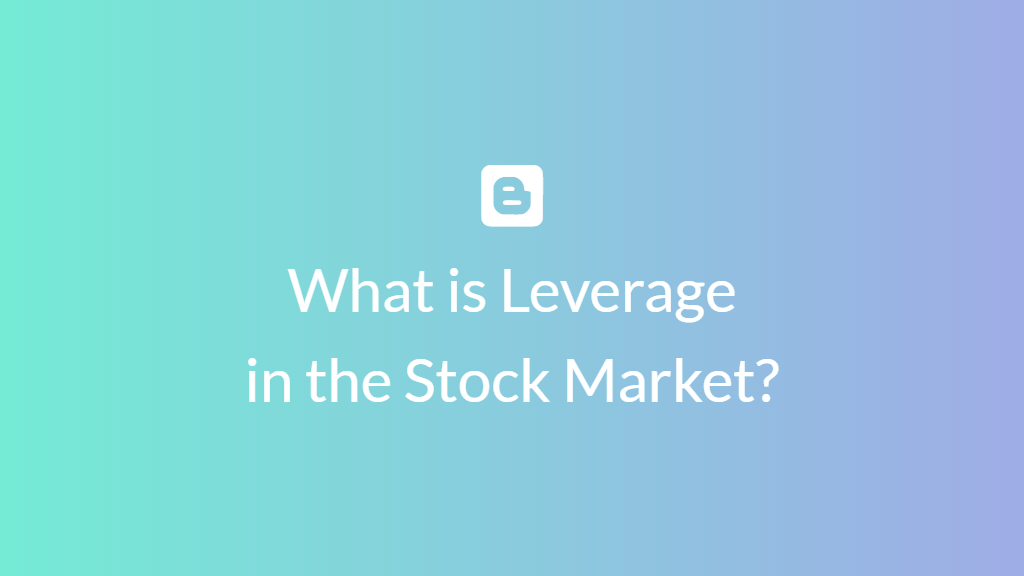What is Leverage in the Stock Market?

Leverage is a powerful financial tool, widely used in the stock market, that enables investors to increase their potential returns by using borrowed money or other assets. Although leverage can amplify gains, it also increases the risk of losses, making it essential to understand its mechanisms, benefits, and potential pitfalls. In this article, we’ll explore leverage in-depth and examine how investors can make informed decisions to maximize their investment strategies.
Leverage in the Stock Market
In the world of finance, leverage refers to using borrowed capital or other financial instruments to increase the potential return on an investment. By leveraging, investors can control a larger amount of assets than they would with just their own money. However, leverage is a double-edged sword: it can magnify both gains and losses. Understanding how leverage works is key to using it effectively in stock market investing.
Understanding the Concept of Leverage
At its core, leverage allows investors to access larger investment opportunities than their capital alone would allow. By borrowing funds, they increase their buying power, which can lead to greater returns if the investment performs well. However, if the investment loses value, leverage amplifies these losses as well, creating additional financial risk.
How Does Leverage Work in the Stock Market?
The Basic Mechanism
In stock market terms, leverage is often employed through a process called margin trading, where investors borrow money from their brokerage firms to buy more stocks than they could normally afford. The investor’s funds act as collateral, and if the stocks perform well, the gains on the leveraged position are significantly larger than what they would be with only personal funds.
Example of Leverage in Action
Consider an investor with $1,000 who borrows an additional $1,000 to purchase $2,000 worth of shares. If the stock price rises by 10%, the investor gains $200 on a $1,000 investment, achieving a 20% return. However, if the stock declines by 10%, the investor’s loss is also magnified, showing the risks involved.
Types of Leverage in Stock Market Investing
Margin Trading
Margin trading is one of the most common forms of leverage, allowing investors to borrow money to buy stocks or other financial instruments. With margin accounts, investors are required to maintain a certain balance, known as maintenance margin, to cover potential losses.
Options and Futures Contracts
Options and futures contracts allow investors to leverage their investments without borrowing money directly. Instead, they use derivative contracts that give them exposure to larger positions for a fraction of the cost, thereby magnifying potential profits or losses.
Leveraged ETFs
Leveraged Exchange-Traded Funds (ETFs) are designed to deliver multiples of the performance of the index or asset they track, making them popular among day traders and investors who seek short-term gains. However, these funds are complex and not ideal for long-term holding due to the high risk and fees involved.
Why Do Investors Use Leverage?
Investors turn to leverage for various reasons, most often to amplify potential gains and make their capital more efficient. By leveraging, investors can control a larger position in the market, which can increase their chances of achieving significant profits from smaller market movements.
Benefits of Leverage
Amplified Returns
When used successfully, leverage can dramatically increase returns. For example, a modest gain on a leveraged position can yield much higher percentage returns compared to an unleveraged one, making it attractive for experienced investors.
Portfolio Diversification
Leverage can also help diversify portfolios by enabling investors to spread their capital across more investments than they could with just their own funds.
Risks Associated with Leverage
Potential for Increased Losses
While leverage can amplify gains, it also increases the potential for significant losses. If an investment’s value decreases, the losses on a leveraged position can be substantial and may even exceed the investor’s initial capital.
Margin Calls
If an investment loses value, brokers may issue a margin call, requiring the investor to deposit additional funds to meet the minimum margin requirement. Failure to do so could result in the broker selling the assets to cover the shortfall.
Volatility Impact
Leverage increases the impact of market volatility on an investor’s portfolio, which can lead to rapid changes in value. This heightened volatility is especially risky in unpredictable or turbulent markets.
Managing Leverage in Your Investment Strategy
Setting Clear Goals
Before using leverage, it’s essential to set clear investment goals and understand your risk tolerance. Leverage is best used by investors who have a strategy in place and a realistic understanding of the risks involved.
Risk Management Techniques
Implementing risk management techniques like stop-loss orders and diversification can help protect your investments when using leverage. Being aware of your position and monitoring market conditions is crucial.
How Much Leverage is Too Much?
Determining the right amount of leverage depends on various factors, including individual risk tolerance, market conditions, and investment goals. Financial experts generally advise against high leverage, especially for beginners, as it increases the potential for substantial losses.
Regulations on Leverage in the Stock Market
FINRA and SEC Guidelines
In the United States, regulatory bodies such as FINRA and the SEC set rules on how much leverage individual investors can use. For instance, FINRA enforces a minimum margin requirement to protect both brokers and investors from extreme losses.
Broker Requirements
Different brokerage firms have varying requirements for leverage, and they may set higher restrictions on margin accounts to manage risk. It’s essential to understand your broker’s terms before entering leveraged trades.
Calculating Leverage Ratios
Leverage ratios help investors understand the level of risk in their leveraged positions. For example, a leverage ratio of 2:1 means the investor is controlling twice their equity with borrowed funds. By calculating and assessing these ratios, investors can make more informed decisions.
Pros and Cons of Using Leverage
While leverage can offer increased profits, it comes with downsides, such as magnified losses and the risk of margin calls. Analyzing the pros and cons of leverage is crucial before incorporating it into your investment strategy.
Leverage and Long-Term vs. Short-Term Investments
Leverage is typically more suitable for short-term investing or trading due to the high risks involved. Long-term investors may want to limit or avoid leverage to minimize the potential for significant losses over time.
Tips for Beginner Investors Using Leverage
- Start small with limited leverage
- Educate yourself on margin requirements and fees
- Set stop-loss orders to manage risk
- Avoid using leverage in volatile markets
- Continuously monitor your positions
Conclusion
Leverage can be a valuable tool in the stock market, enabling investors to increase their potential returns. However, the risks of using leverage are substantial, and it requires careful management and a thorough understanding of the stock market to avoid significant losses. For those willing to take on the added risk, leverage can help achieve investment goals faster, but it’s essential to weigh the benefits against the potential pitfalls.
Frequently Asked Questions (FAQs)
- What is leverage in simple terms? Leverage is borrowing money to increase your investment capacity, which can amplify both gains and losses.
- Is leverage safe for beginners? Leverage carries high risk and is generally recommended for experienced investors who understand how to manage it effectively.
- Can I lose more than my investment with leverage? Yes, if a leveraged investment loses value, you can lose more than your initial investment, especially in margin trading.
- What are leveraged ETFs? Leveraged ETFs are funds that use financial derivatives and debt to amplify the returns of an underlying index. They are typically suited for short-term trading.
- How does a margin call work? A margin call is issued when the value of an investment falls, and it requires the investor to add funds to maintain the minimum margin level, or the broker may sell assets to cover the shortfall.















Post Comment